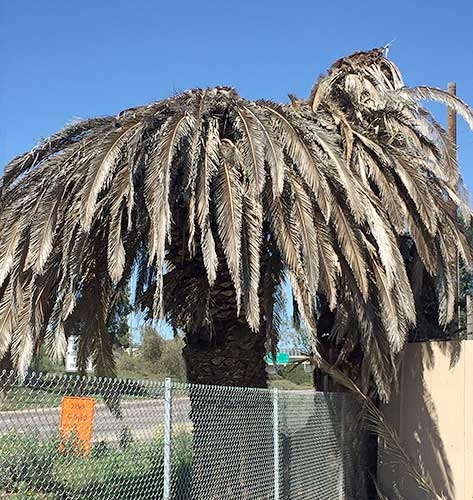[From the August 2016 issue of the UC IPM Green Bulletin]
The South American palm weevil (SAPW), Rhynchophorus palmarum, was recently discovered in a Canary Island date palm in San Ysidro, southern San Diego County.
Twenty additional Canary Island date palms in the San Ysidro area appear to be infested, but have not yet been confirmed.
Weevil Biology
The biology of SAPW is similar to the red palm weevil that was eradicated from Laguna Beach, Orange County, between 2010–2012. ![Figure 2. South American palm weevil cocoon. [L. Taylor, San Diego County] Figure 2. South American palm weevil cocoon. [L. Taylor, San Diego County]](http://ucanr.edu/blogs/UCIPMurbanpests/blogfiles/38716.jpg)
The SAPW, native to Mexico and Central and South America, destroys the apical growth of the palm by feeding on the growing tissue in the palm crown, eventually killing the palm (Figure 3). This differs from the symptoms of fusarium wilt which causes dying of lower branches.
Symptoms and Signs

Signs of the pest include accumulated frass (insect excrement) at the base of the leaves and pupal cases on the ground near the tree. Holes and tunneling can also be found at the base of palm fronds.
In addition to Canary Island date palms, the South American palm weevil is also known to attack coconut palms, date palms, and the king sago palm in the cycad family.
It is believed that the spread of this pest can be delayed with the fast detection and removal of infested trees. Chipping (Figure 4), burning, and burying infested material deeply can reduce the likelihood that SAPW will emerge and escape from infested palms.
Report a Find
![Figure 4. Chipping Canary Island date palm to reduce SAPW population. L.Taylor, San Diego County] Figure 4. Chipping Canary Island date palm to reduce SAPW population. L.Taylor, San Diego County]](http://ucanr.edu/blogs/UCIPMurbanpests/blogfiles/38719.jpg)
-Jennifer Pelham, UCCE Area Environmental
Horticulture Advisor UCCE San Diego & Orange counties,
jlpelham@ucanr.edu;
-Tracy Ellis, Agricultural Entomologist, County of San Diego, Tracy.Ellis@sdcounty.ca.gov
![Figure 1. South American palm weevil adult (R. palmarum). [T. Ellis, San Diego County] Figure 1. South American palm weevil adult (R. palmarum). [T. Ellis, San Diego County]](http://ucanr.edu/blogs/UCIPMurbanpests/blogfiles/38715.jpg)